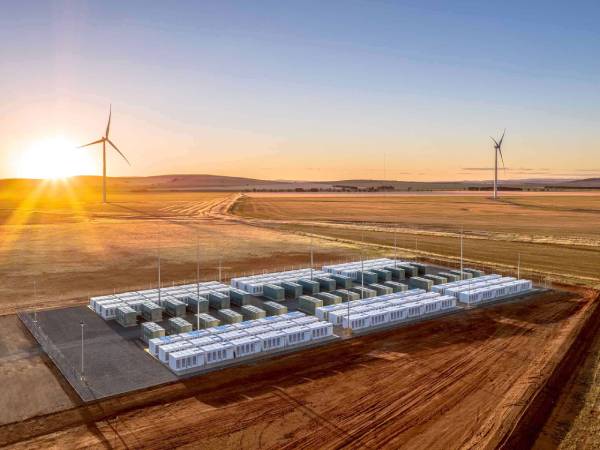
💡 Optimist's Edge: Big batteries are the missing piece of the energy puzzle
Is building large battery storage as useful as building a big banana? Australian Prime Minister Scott Morrison thought so, but the Tesla battery in Australia has surprised critics and shown us the missing piece of the energy puzzle.
Share this story!
Summary
📉 What people are wrong about
“I mean, honestly, by all means have the world’s biggest battery, have the world’s biggest banana, have the world’s biggest prawn like we have on the roadsides around the country, but that is not solving the problem.”
- Scott Morrison, Australian Prime Minister
That was one reaction to the proposal to build large battery storage in South Australia to help avoid future blackouts. It is representative of much ridicule that has been heaped on large batteries. Lack of knowledge is probably a large factor in the resistance because these kinds of batteries are new.
📈 Here are the facts
The big banana… sorry, the big battery actually solved much of the problem in South Australia, and the area has not experienced any blackouts since.
The battery has saved millions of dollars for the consumers and also made millions of dollars for the owner. Now several other batteries are being built in Australia and other places in the world.
The cost of these batteries will very likely go down in the coming decade, according to Wright’s Law.
💡 The Optimist’s Edge
Over the coming decade large battery storage – big battery parks – will become an integral part of our energy system, at an accelerating pace because of the fast dropping costs of building them and demonstrated value in having them.
They will make renewable energy work better since they can dispose stored solar and wind energy when the sun is not shining and the wind is not blowing.
Big batteries will also help balance the grid.
👇 How to get the Optimist’s Edge
Regions and countries that act quickly will sooner reap the benefits of a stable grid and low energy prices.
For entrepreneurs, this is a huge opportunity. You can help the world transition away from fossil fuels. Thousands of large-storage batteries will be built – you can be the one to build them.
If you want to invest in battery storage there are several companies that might be interesting. Among them are Tesla, Fluence, Neoen, NextEra Energy, and Vistra Corp.
📉 What people are wrong about
“I mean, honestly, by all means have the world’s biggest battery, have the world’s biggest banana, have the world’s biggest prawn like we have on the roadsides around the country, but that is not solving the problem.”
That was then-Federal Treasurer, now Prime Minister, Scott Morrison’s reaction to the news that Tesla was going to build a large battery in South Australia, to help balance the grid and avoid new blackouts, like the one in 2016 that affected almost a million people.

The quote is a good representation of the reactions we got when we proposed to build large battery storage in Sweden, this winter during a debate on the Swedish energy system.
Other people in Australia were not as colorful in their language as Morrison, but even supposed experts like the Australian Energy Market Operator published a report claiming that the maximum size of a utility-scale lithium-ion battery would be 1MW. A battery of 100 MW, that Elon Musk proposed building in less than 100 days, was not something that would make a meaningful contribution to the energy system in 10 to 20 years, they said.
Australia was first in having this debate about batteries. Others have learned from the example of the Tesla battery, but many still come up with almost the exact same arguments as was heard in Australia before it was built.
Others, who are not as dismissive, have not yet learned of the potential benefits of large battery storage.
📈 Here are the facts
The big banana… sorry, the big battery actually solved much of the problem in South Australia.
The background is a big blackout that occurred in 2016. South Australia was experiencing a large storm, with at least two tornadoes and 80 000 lightning strikes. The storm did damage to the power grid, including three of the four interconnectors connecting the Adelaide area to the north and west of the state. This put a lot of stress on the grid and parts of it started disconnecting, which led to wind farms shutting down. That led to more disconnects, more lost power from wind farms and eventually, the entire grid went dark.
Then South Australia experienced two more big blackouts in just a few months, and the debate over how to solve this became intense.
It was then that Elon Musk entered the arena with a proposal to build a 100MW battery within 100 days, or it would be free.
The battery is called Hornsdale Power Reserve and was eventually built under cost in just two months. It has worked better than almost everyone anticipated.

It was put into action even before it had officially launched, adding 70MW of stored wind power into the grid, when prices soared due to heat and low wind energy production and no energy came from a coal power plant.
In its first year of operation, in 2018, the battery saved the energy customers A$40 million, and in 2019 it jumped to A$116 million.
Two weeks after launch the battery was tested again. Suddenly a large coal power plant disconnected causing a loss of 560MW and a slump in frequency on the network. Just milliseconds later the Tesla battery stepped in, injecting 7.3MW into the network, to slow down and reverse the slump in frequency that had fallen below 49,80 Hertz, which is the normal frequency. This was several seconds before the assigned backup, another coal plant, stepped in.
The battery has also been lucrative for the owner of it. In 2020 Neoen made A$ 46 million from energy storage, which is half the cost to build the entire battery. It is no surprise then that we now see the first big battery in Australia being built without government support.
The Hornsdale battery was the world’s largest when it was built, but now we see many large battery projects around the world.
“Utilities installed 987 megawatts of energy storage in 2017, surged to 3.5 gigawatts in 2020, and are projected to put in 10.2 gigawatts in 2023, according to BloombergNEF.”
Bloomberg NEF forecasts that the global energy storage will increase 122 times from 2018 to 2040. It would not be surprising if that number is way too low.
The key is rapidly falling battery costs. Between 2010 and 2020 the cost of lithium-ion batteries dropped 85 percent.
If we apply Wright’s Law to battery pack prices, it will fall 18 percent per doubled total production. According to Bloomberg NEF, that means a battery pack cost of $93/kWh by 2024 and $61/kWh by 2030. Again – it would not be surprising if those numbers are too pessimistic.
“If we're serious about a long-term future as a global civilization, we're going to need to get serious about energy storage over the next fifty years. Over the half-century to come, the gradual electrification of transport, and the increasing demand for electricity will create the potential to strain the global network if we're not prepared,” says Tony Morley, an energy expert from Australia.

“What's needed is a gradual transition to greater renewable energy generation and an effective mode of storing and dynamically shifting that energy. It's an enormous challenge, but one that will see battery storage play a key role. Irrespective of the mode of base-load power generation, battery storage will be instrumental in load balancing, and frequency moderation,” Tony Morley tells Warp News.
💡 The Optimist’s Edge
Over the coming decade large battery storage – big battery parks – will become an integral part of our energy system, at an accelerating pace because of the fast dropping costs of building them and demonstrated value in having them.
They will make renewable energy work better since they can dispose of stored solar and wind energy when the sun is not shining and the wind is not blowing.
Big batteries will also help balance the grid when other power plants disconnect or go offline for some reason. Since the batteries are very fast in responding, often faster than other backups, the grid will be better balanced.
During peak hours of energy consumption, the batteries will dispose of energy into the system and help keep the lights on, and don’t let the price of electricity spike as much.
Large batteries can sometimes replace other costly investments, like expensive interconnector high-voltage cables between grids.
During hours when demand is low and prices are low, often at night, the battery can be charged and that electricity can later be disposed of during the day when demand is high and prices are going up. This will help keep prices down, but also make money for the battery owner.
👇 How to get the Optimist’s Edge
Regions and countries that act quickly will sooner reap the benefits. A stable grid and low energy prices are important for both the economy and job growth. As the world transitions to electric vehicles and other solutions that replace fossil fuels, the demand for energy will go up.
Both politicians and entrepreneurs are important in this transition.
The energy system is often under some sort of political control and some investments are decided or at least heavily influenced by governments. Therefore we need to inform our political leaders of the huge potential in large-scale battery storage.
For entrepreneurs, this is also a big opportunity. You can both provide something valuable that helps the world transition away from fossil fuels but also potentially make a lot of money building these large battery parks.
“While many large battery developers are playing their card close to their chest regarding development, operational and maintenance costs, and profit margins - it's becoming more clear with each passing year that there's a case for battery storage,” says energy expert Tony Morley.
If you want to invest in battery storage there are several companies that might be interesting. Matt Bohlsen, the author of Trend Investing at Seeking Alpha, shows several examples of energy storage companies. Among them:
Tesla, Fluence, Neoen, NextEra Energy and Vistra Corp. He also lists battery manufacturers and funds, like Amplify Lithium & Battery Technology ETF and Global X Lithium & Battery Tech ETF.
Mathias Sundin
This is not advice to invest in any particular company. Do your own research and make your own investment decision.
❓ What more can you do?
We are happy if you would like to share your thoughts about this article with other Premium Supporters on our Facebook group.
By becoming a premium supporter, you help in the creation and sharing of fact-based optimistic news all over the world.


